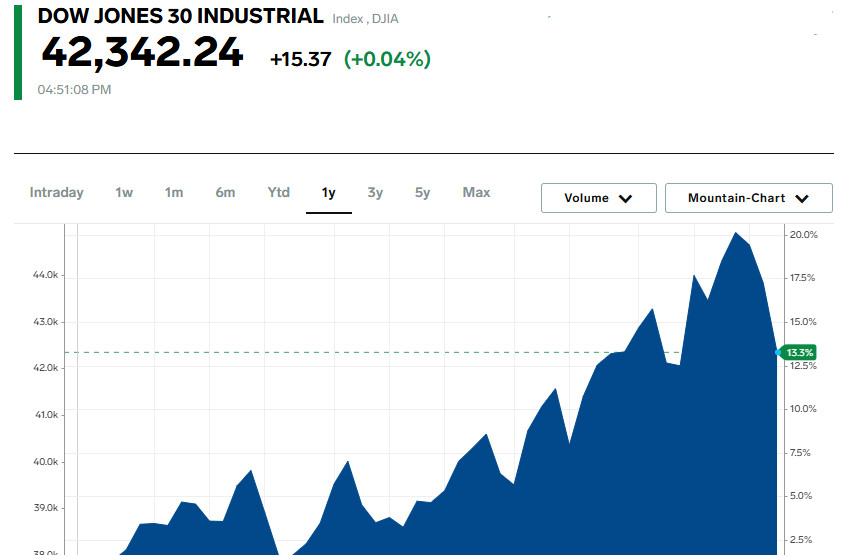Markets Recover, But Cautiously
U.S. stock indexes ended the day little changed on Thursday, reversing their morning gains. This happened as investors tried to digest the previous sharp decline caused by unexpected forecasts from the Federal Reserve. The central bank said it expects less interest rate cuts and continued high inflation next year.
Fed Throws Markets a Spook with Its Forecasts
In the previous session, investors were shaken by the Fed's stance, which revised its expectations for the dynamics of rates and inflation. Now market participants are preparing for the fact that monetary policy will remain tight longer than previously expected. This has added uncertainty and increased pressure on stocks.
The economy confirms the regulator's words
On Thursday, economic statistics confirmed the validity of the Fed's forecast. The number of initial applications for unemployment benefits unexpectedly fell more than analysts expected, which indicates the stability of the labor market. Moreover, the GDP growth rate for the third quarter was revised upward - from 2.8% to an impressive 3.1%.
Despite favorable macroeconomic data, investors preferred to take a wait-and-see attitude. The unpredictability of the Fed's future policy and the risks of high inflation continue to put pressure on market sentiment.
Wall Street ends the day in thought
The Dow Jones Industrial Average rose by a symbolic 15.37 points (0.04%), closing at 42,342.24. Meanwhile, the S&P 500 fell 5.08 points (-0.09%) to end the day at 5,867.08, while the Nasdaq Composite lost 19.92 points (-0.10%) to end the day at 19,372.77.
These changes demonstrate a mixed reaction from markets to economic and monetary cues.
Dow Breaks Losing Streak
Despite the slight gain, the Dow managed to snap a grim streak of ten consecutive session declines, the longest since 1974. However, the overall sentiment remains cautious, especially after Wednesday's significant losses.
Earlier, the Dow and S&P 500 suffered their biggest daily drop since August, while the Nasdaq posted its worst performance since July. The main reason was the Fed's new forecast, according to which interest rates will be cut more slowly than expected in 2025. Now, only two cuts of 25 basis points are forecast, down 0.5 percentage points from September's forecast.
A positive year-end result eases concerns
Despite recent wobbles, the year-end performance remains impressive. The S&P 500 is up 23%, the Dow is up over 12%, and the Nasdaq is up 29%. These numbers highlight the market's resilience in a challenging macro environment.
Rates, Bonds, and Expectations
Rate expectations continue to shift. Traders previously expected three cuts by the end of 2025 to see a maximum of two, with the first not expected until mid-year. The adjustment has added to the pressure on bond markets, where the yield on the 10-year Treasury note has risen to 4.594%, the highest in seven months.
Fear Index Eases Slightly
After peaking at 27.62 the day before, the CBOE Volatility Index (VIX), which measures investor anxiety, fell to 24.09. This signals some easing of tension, although the overall market sentiment remains cautious.
Investors continue to adapt to new economic conditions and the regulator's forecasts. In the coming sessions, the main focus will be on macroeconomic data and statements by Fed officials, which may shed light on the future course of monetary policy.
Banks Strengthen Thanks to Yields
The financial sector showed positive dynamics: shares of banking companies (index .SPXBK) rose by 0.3%. This is due to the growth in government bond yields, which traditionally improves the profitability of credit institutions. In addition, investors are counting on the easing of sector regulation with the arrival of the new Donald Trump administration.
Tech Under Pressure
Micron Technology (MU.O) was in the spotlight, but for disappointing reasons. Its shares tumbled 16.2% after issuing weak quarterly revenue and profit guidance that missed market expectations. The hit was reflected in the PHLX Semiconductor Index (.SOX), which lost 1.6%.
Builders Slip
A weak fourth-quarter performance weighed on homebuilder Lennar (LEN.N), which fell 5.2%. That sent the PHLX housing index down 2.6%, a stark reminder of the challenges facing the construction sector.
Bears Prevail
On the New York Stock Exchange, decliners outnumbered advancers by a 2.18-to-1 ratio. On the Nasdaq, the ratio was 1.3-to-1, indicating a bearish tone.
Highs and Lows: The Week's Picture
The S&P 500 posted two new 52-week highs and 40 new lows, while the Nasdaq Composite posted 29 new highs and a whopping 276 new lows. This highlights that the market remains under significant pressure despite localized growth spurts.
Trading volumes are growing
Total trading volume on US exchanges amounted to 16.33 billion shares, which is higher than the average of 14.52 billion over the past 20 trading days. This growth may indicate increased activity by market participants in the face of uncertainty.
Commodities and bonds: mixed signals
Amid macroeconomic tensions, US Treasury yields reached their highest since May, demonstrating a confident rise. At the same time, crude oil prices fell, while gold rose. This reflects investors' desire to hedge risks in the face of gradual but cautious easing of Federal Reserve policy.
The market remains in a holding pattern, balancing hopes for further growth and fears of possible stagnation. Participants continue to closely monitor economic signals and the actions of the regulator, preparing for new turns.
The Fed and Investors: A Wave of Anxiety
U.S. stock markets suffered their biggest selloff in months on Wednesday, driven by the Federal Reserve's economic outlook and a signal that the pace of interest rate cuts is slowing.
"Some investors are concerned that Fed Chairman Jerome Powell's comments may indicate a lack of intent to cut rates," said Bill Merz, head of equity research at U.S. Bank Wealth Management.
Merz emphasized that the market reaction was tied to specific language Powell used during his press conference. "It shows how much market participants are trying to interpret the Fed's actions in real time," he added.
Global Central Banks: Mixed Actions
The Fed was not the only regulator to end the year with important decisions. The central banks of the UK, Japan, Norway and Australia kept rates unchanged. At the same time, Switzerland and Canada went for a 50 basis point reduction, while the Swedish Riksbank and the European Central Bank limited themselves to a 25 basis point reduction.
The US economy continues to surprise
The latest economic data from the US once again confirmed the resilience of the American economy. The revised GDP growth for the third quarter was higher than expected - 3.1%. Optimism was further boosted by a reduction in the number of applications for unemployment benefits and an unexpected increase in sales in the secondary housing market.
Economic stability is a reason for cautious optimism
Thomas Martin, Senior Portfolio Manager at GLOBALT, assessed the events as a positive signal: "The Fed continues to fight inflation, and the economy is showing strength. The final GDP growth of 3.1% is not bad at all."
The perception of signals from the Fed and other central banks divides market participants into pessimists and cautious optimists. Investors continue to assess the prospects against the backdrop of a stable US economy, while trying to figure out the future policy of regulators.
Fed sets tone for global markets
European stock markets ended the day significantly lower, posting their biggest weekly decline in five weeks, as tough comments from the US Federal Reserve prompted investors to abandon risky assets and seek safe havens.
Overall declines in indices: global performance
The MSCI Global Equity Index (.MIWD00000PUS) fell 3.70 points (-0.44%) to end at 841.74. The European STOXX 600 (.STOXX) lost 1.51%, while the broader FTSEurofirst 300 (.FTEU3) fell 30.90 points (-1.51%), highlighting the broad weakness in European markets.
Asian and Emerging Markets in the Red
It wasn't just Europe that was under pressure, with the MSCI Emerging Markets Index (.MSCIEF) falling 12.45 points (-1.14%) to close at 1,082.86. Asian markets also followed the global sentiment. The MSCI Asia-Pacific Ex-Japan Index (.MIAPJ0000PUS) fell 1.41% to 572.84.
Japan's Nikkei Index (.N225) ended the day down 268.13 points (-0.69%) to 38,813.58, indicating a broader downward trend in the region amid investor wariness.
Fed Tightening Key Catalyst
The Federal Reserve's tough talk continues to weigh on global markets. Fears of longer-term high interest rates are forcing investors to adjust their portfolios, shifting their focus to less risky assets.
Amid volatility, global investors will continue to monitor the actions of the Fed and key economic indicators. Waiting for new signals from central banks will determine further sentiment on the stock exchanges.
Dollar strengthens amid Fed caution
The dollar recovered its positions after an initial weakening and ended the trading session with a slight increase. Market participants continue to evaluate the Federal Reserve's cautious approach to monetary easing. The dollar index, which tracks the U.S. currency against a basket of six major currencies, increased by 0.11% and reached 108.38.
The euro also strengthened slightly, rising by 0.12% to $1.0364, while the Japanese yen lost value - the dollar rose by 1.69% against the yen, reaching 157.41.
Cryptocurrencies under pressure
The cryptocurrency market continues to decline after the Fed's comments. Bitcoin fell by 5.07%, reaching $95,811.00, while Ethereum lost 9.13%, stopping at $3,352.50. These changes indicate continued volatility in digital assets amid changing economic forecasts.
Oil prices fall on demand concerns
Oil prices fell amid muted expectations for central bank easing in the US, Europe and Asia. These signals increased concerns about a possible reduction in global demand for the commodity. The cost of US crude oil decreased by 0.95%, reaching $69.91 per barrel, while Brent crude oil fell by 0.69%, settling at $72.88 per barrel.
Gold: Gains with caveats
Gold posted modest gains on the back of Fed caution, but gave up some of its early gains on positive US economic data. Spot gold rose 0.35% to $2,596.60 an ounce, but US gold futures fell 1.69% to end the day at $2,592.00 an ounce.
Uncertainty Remains
Markets remain mixed, reflecting the impact of signals from the Fed and other central banks. Investors continue to balance caution with opportunity amid ongoing volatility.





















